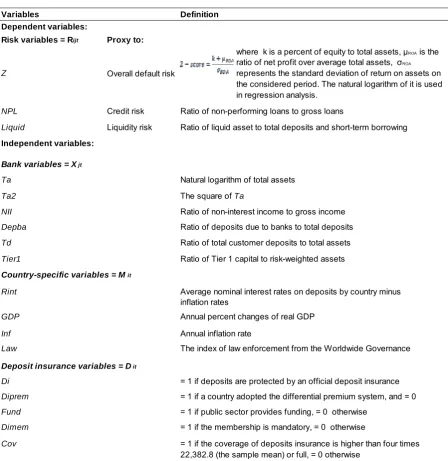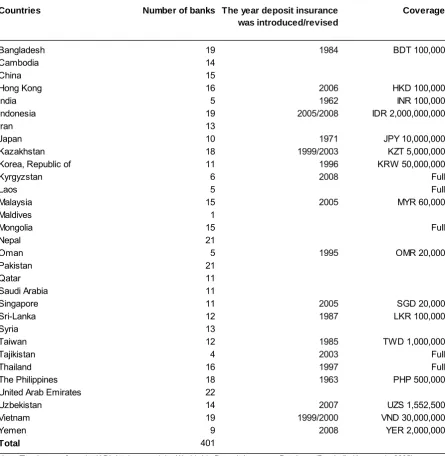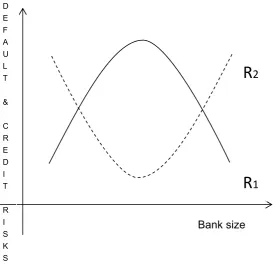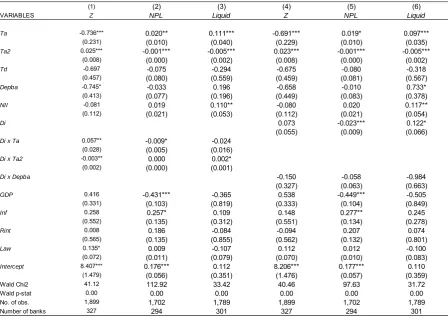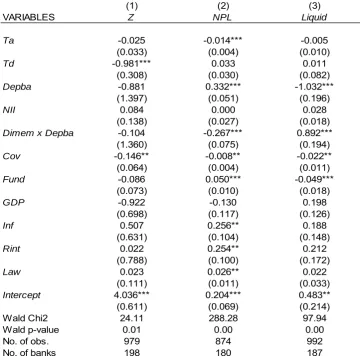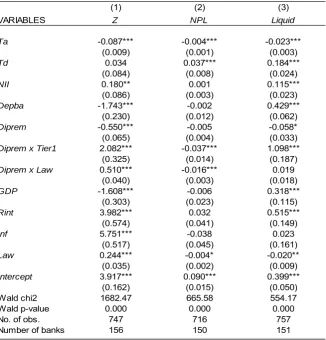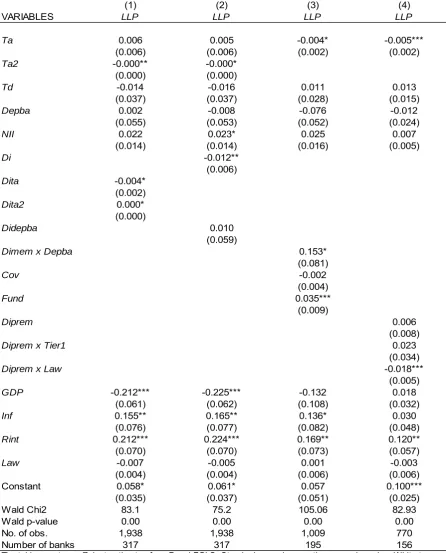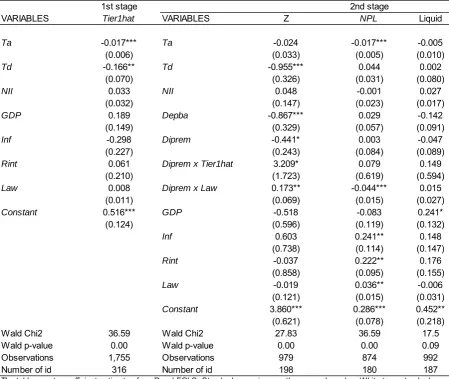The Effect of Deposit Insurance on Risk Taking
in Asian Banks
Enerelt Enkhbold
National University of Mongolia
E-mail: eenkhbold@adb.org
Batnairamdal Otgonshar
Resource Investment Capital LLC & Origo Partners PLC
Ulaanbaatar, Mongolia
E-mail: nagi.otgonshar@resource-cap.com
Received: Jan. 9, 2013 Accepted: April 1, 2013 Published: June 1, 2013
doi:10.5296/ajfa.v5i1.3023 URL: http://dx.doi.org/10.5296/ajfa.v5i1.3023
Abstract
This paper uses a panel database of 401 banks in 31 Asian countries over the period from 2000 to 2010 to examine the effects of deposit insurance on banks’ risk-taking incentives. We find that risk-taking incentives vary with bank size and risks. In addition, differentiated premiums may not accurately reflect the level of risk that a bank poses. In the presence of a deposit insurance scheme, the pattern of the non-linear relationship between bank size and risk-taking significantly changes. Our results suggest that market discipline exercised by banks is stronger in the presence of mandatory deposit insurance scheme. Government-funded deposit insurance funds allow Asian banks to take a higher risk. A risk-based deposit insurance scheme functions more effectively in the countries with good regulatory framework and institutional quality.
Keywords: deposit insurance, Asia, Emerging markets, Bank risk
JEL classification codes: G21, G22, G28
The deposit insurance system has proliferated around the world in the last two decades and the relationship between deposit insurance, and bank risk-taking has been extensively studied in the banking literature. There are currently 104 countries with explicit or implicit deposit insurance scheme in operation worldwide and twenty years ago, it was only less than twenty countries adopted a deposit insurance scheme, according to the International Association of Deposit Insurers (IADI). In spite of its widespread use, empirical studies provide conflicting results on the impact of (explicit) deposit insurance schemes on the risk-taking of banks.
The regulators can prevent bank runs with a generous deposit insurance scheme (Morrisons & White, 2006). Explicit or implicit deposit potentially reduce the likelihood and severity of bank runs during a financial crisis and thus can be an effective financial tool for governments to ensure the safety and soundness of the financial system and to protect depositors from losses by insolvent banks during crisis times. Further deposit insurance can help to restore depositors’ confidence and thus promote financial intermediary development.
In spite of the positive effects of deposit insurance, there is a widespread consensus that guarantees of depositors and creditors induce banks to take excessive risks. The voluminous literature indicates adverse consequences of deposit insurance related to moral hazard and adverse selection. According to the moral hazard theory, the insurant tends to be less careful about risk behavior since the potential loss is protected by the deposit insurer. The moral hazard problem associated with deposit insurance is usually interpreted in terms of an incentive for a bank to increase the risk in search for higher profits (Forssbæck, 2011). Martin (2006) argues that complete deposit insurance weakens market discipline and increases the chance of banking failures. Depositors and banks protected from the negative consequence of risk-taking will not hesitate to engage in risky banking practices. On the other hand, a handful of contrasting studies find no significant relationship between deposit insurance and bank risk taking.
The aim of this study is to assess the impact of deposit insurance on bank riskiness in Asian countries – it extends the current analyses into the Asian context. In the literature, there are a number of tests for the impact of deposit insurance on bank risk-taking in the US and Europe but very few in Asia. Several studies include the data of Asian banks in their sample set, but their primary research focus was not on the continent (Angkinand & Wihlborg, 2007; Demirguc-Kunt & Detragiache, 2000). The institutional background of the Asian banking system is special for several reasons. Firstly, emerging markets dominate the Asian economy. Secondly, Asian governments heavily regulate the financial sector, though several countries attempt to liberalize their economies. Finally, non-listed banks outnumber listed banks in Asia, and comparably weak transparency is likely to generate a moral hazard and contribute to bank runs.
insurance fund on banks’ risk-taking.
The key findings are as follows: Firstly, risk-taking differs across bank size and the pattern of non-linear relationship between risk-taking and bank size changes across bank risks in the presence of explicit deposit insurance. Secondly, a mandatory deposit insurance scheme disciplines banks to monitor one another’s risk-taking. The findings suggest that the increase in government funding of deposit insurance incentivizes banks’ risk-taking and existing risk-based premium systems functions better in countries with stronger institutional environments.
The paper is organized as follows: Section II reviews the empirical literature on deposit insurance and bank risk. Section III introduces the data and methodology, hypotheses and variables in detail. Section IV discusses the empirical findings of this study, and section V presents the conclusion.
2.Previous Empirical Evidence
Most research indicates that deposit insurance is responsible for excessive risk-taking in the financial sector. Several studies identified a positive relationship between deposit insurance and banking instability. Wheelock (1992) finds that deposit insurance is more likely to exacerbate bank failures. He also finds that despite strict regulation lessened risk-taking, a high proportion of insured banks resulted in higher bank failure rates in Kansas during the 1920’s. He noted deposit insurance has been one of the important causes of bank failures during the 1920’s (Alston et al., 1994). Chernykh and Cole (2011) analyze bank-level data for 800 institutions in the Russian Federation over the period 2004-2006 and used several types of accounting information. They find that the ratio of equity to total assets ratio declined while the ratio of loans to total assets increased after the implementation of deposit insurance and conclude that deposit insurance created a moral hazard problem in the form of increased risk-taking.
Furthermore, Grossman (1992) pointed out that the combination of deposit insurance and deregulation leads banks to undertake more risk. He adds that flat rate insurance creates a moral hazard problem since banks do not bear costs associated with engaging in their risky behavior. Wheelock and Kumbhakar(1995) conclude that insured banks are prone to increase risk-taking in order to avoid subsidizing other insured banks. They argue that a voluntary deposit insurance scheme in which premiums are not sufficiently sensitive to differing risk
levels attracts risk-prone banks; however, they find no evidence that deposit insurance encourages depository institutions to hold smaller reserves. Using panel data for 61 countries over the period 1980-1997, Demirgüc-Kunt and Detragiache (2000) conclude that the explicit deposit insurance increases the likelihood of bank failures where the institutional environment is weak. According to their study, the adverse impact of deposit insurance on financial stability is more likely to be stronger when the insurance coverage offered to depositors is more extensive, and where the system is funded and managed by the government.
that are low in political conditions and high in corruption, explicit deposit insurance has adverse effects. Laeven (2002a) stretches further to acknowledge that existing insurance schemes create moral hazard for banks but the magnitude of incentive problems differs due to variation in governance structures and institutional environments. He (2002 a, b) investigates the effect of deposit insurance on risk-taking measured by implicit value of deposit insurance services and suggests that a deposit premium has some power in forecasting bank failures because the cost of insurance reflects the riskiness of deposit-taking institutions. Analyzing bank-level data for 100 countries including 41 emerging markets, Angkinand and Wihlborg (2006) find a robust estimation for a non-linear relationship between deposit insurance coverage and bank risk-taking. They note that effects of ownership structure on risk-taking differ through market discipline and optimal deposit insurance coverage varies in countries in Asia and Eastern Europe.
Davis and Obasi (2009) test the impact of a design package of deposit insurance and bank risk taking activity and report that design features have different effects on the different financial soundness ratios. They emphasize the impact of a deposit insurance system on bank asset-side risk. Banks with a high share of large depositors undertook relatively less risk before the insurance system established in the context of Bolivia, but banks appear to take higher risk and do not seem to compensate increasing risk by adjusting requirements for collateral and maturity after the introduction of deposit insurance (Ioannidou & Penas, 2010). This is consistent with the fact that large depositors have greater ability to monitor banks in unguaranteed circumstance as proposed by England (1988). Distinguin et al. (2011) showed that the adoption of the formal deposit insurance encouraged risk taking incentives for European banks in the 1990s. Their study also supports the view that explicit deposit insurance favors market discipline when some creditors are excluded from deposit insurance coverage.
3.Data and Methodology
3.1.Methodology
Deposit insurance can weaken the market discipline and encourage banks’ incentives to take on too much risk in search for higher profits. Depending on country’s institutional circumstances and economic development, banks operate in environments with different design features of deposit insurance scheme. Consequently, we focus on measures of banks’ risks: overall default risk, asset (credit) risk and liquidity risk.
Hypothesis 1: The presence of a deposit insurance scheme generates incentives that lead banks to take on excessive risk.
Hypothesis 2: A deposit insurance scheme with a mandatory membership encourages market discipline exercised by banks.
Hypothesis 3: Combined with good regulatory framework and institutional quality, a risk-based premium system eliminates the free-rider problem and discourages banks’ risk-taking.
To test these hypotheses, we employ information on asset and liability structure, sources of income, along with information on country specific variables. The specification used here follows Forssbæck (2011). This paper uses three measures of bank risks - overall default risk, liquidity risk and credit risk. The main model of this study is as follows:
= + + + + (1)
where represents a set of dependent variable of risks (or risk-taking) of individual banks, represents a vector of control variables unique to bank j at the period t-1, stands for a vector of country-specific variables in country at the period t-1 and represents a vector of indicators describing the deposit insurance system in country at the period t.
Table 1. Definition of variables
We interact our deposit insurance variables with some of bank variables. These interaction variables allow us to account for the effects of deposit insurance’s features on banks’ characteristics and risk-taking. Similar to other studies on risk-taking, we expect that the deposit insurance dummy is positively related to banks’ risk taking. On the other hand, increasing bank size will positively affect overall risk and other risk measures in the presence of a deposit insurance scheme.
If the mandatory membership encourages banks’ risk-shifting to one another at the expense of a deposit protection system, the coefficients on the interaction variable, deposit insurance membership dummy multiplied by deposits due from banks over total assets, shall be significant. If this holds true, banks will witness an increase in interbank deposits over total assets.
Variables Definition
Dependent variables:
Risk variables = Rijt Proxy to:
Z Overall default risk
NPL Credit risk
Liquid Liquidity risk
Independent variables:
Bank variables = Xjt Ta Ta2 NII Depba Td Tier1
Country-specific variables = Mit Rint
GDP
Inf
Law
Deposit insurance variables = Dit Di
Diprem
Fund
Dimem
Cov
Ratio of liquid asset to total deposits and short-term borrowing
where k is a percent of equity to total assets, μROA is the
ratio of net profit over average total assets, σROA
represents the standard deviation of return on assets on the considered period. The natural logarithm of it is used in regression analysis.
Ratio of non-performing loans to gross loans
Annual percent changes of real GDP Natural logarithm of total assets
The square of Ta
Ratio of non-interest income to gross income Ratio of deposits due to banks to total deposits Ratio of total customer deposits to total assets
Ratio of Tier 1 capital to risk-weighted assets
Average nominal interest rates on deposits by country minus inflation rates
= 1 if the coverage of deposits insurance is higher than four times 22,382.8 (the sample mean) or full, = 0 otherwise
Annual inflation rate
The index of law enforcement from the Worldwide Governance
= 1 if deposits are protected by an official deposit insurance = 1 if a country adopted the differential premium system, and = 0 = 1 if public sector provides funding, = 0 otherwise
To test the third hypothesis, we run regressions using the interaction variables associated with risk-based deposit insurance premium, law enforcement and the tier 1 capital ratio. If an increase in the tier 1 capital ratio interacted with risk-based premium dummy positively affects bank risks, we may conclude that risk-based deposit insurance premiums do not properly reflect risks posed by banks. We also expect that higher law enforcement index strengthens risk-based deposit insurance systems.
We investigate the effects of a deposit insurance system on bank risks by employing generalized least squares. The feasible generalized least square model (FGLS) allows us to estimate the equation (1) using the unequally spaced panel data where the unbalance is due to random attrition.1 As described in the data section, our panel is unbalanced and consists of 2,940 bank-year observations.
3.2.Data and empirical design
In examining the impact of deposit insurance on banks’ risk-taking, the panel data of Asian banks are used. This data set contains the annual information about 401 banks from 2000 to 2010. There are very few prior studies that solely focus on Asia, and most of those prior studies analyzed the data mainly of developed and high income countries. Some important economies, including China and India, are left out of the research due to their relatively late liberalization in financial markets (e.g. Demirgüç-Kunt & Detragiache, 2000). The number of banks studied is presented in Table 2.
Table 2. Number of banks per country used in this study
Accounting data for individual banks are from Bankscope Fitch IBCA. First, 25 top banks from each country were selected based on total assets size (625 banks). In addition to data from twenty countries with a deposit insurance scheme, the data of eleven countries with no deposit insurance scheme are included to compare risk-taking behavior under different conditions. Although Lao DPR does not have an official deposit insurance system, the IADI includes it in the list of the countries with effective deposit protection systems worldwide, and thus Laos is included in the eleven countries in this study. The number of banks available in the Bankscope database varies. For Kyrgyzstan, Laos, Oman, Sri-Lanka, Tajikistan, Uzbekistan, Yemen, Iran, Syria, Saudi Arabia, Qatar, Maldives and Cambodia, each individual sample contains less than 25 banks in the Bankscope database. The data used for commercial banks of Mongolia in this study were obtained from the Bank of Mongolia.
Countries Number of banks The year deposit insurance
was introduced/revised
Coverage
Bangladesh 19 1984 BDT 100,000
Cambodia 14
China 15
Hong Kong 16 2006 HKD 100,000
India 5 1962 INR 100,000
Indonesia 19 2005/2008 IDR 2,000,000,000
Iran 13
Japan 10 1971 JPY 10,000,000
Kazakhstan 18 1999/2003 KZT 5,000,000
Korea, Republic of 11 1996 KRW 50,000,000
Kyrgyzstan 6 2008 Full
Laos 5 Full
Malaysia 15 2005 MYR 60,000
Maldives 1
Mongolia 15 Full
Nepal 21
Oman 5 1995 OMR 20,000
Pakistan 21
Qatar 11
Saudi Arabia 11
Singapore 11 2005 SGD 20,000
Sri-Lanka 12 1987 LKR 100,000
Syria 13
Taiwan 12 1985 TWD 1,000,000
Tajikistan 4 2003 Full
Thailand 16 1997 Full
The Philippines 18 1963 PHP 500,000
United Arab Emirates 22
Uzbekistan 14 2007 UZS 1,552,500
Vietnam 19 1999/2000 VND 30,000,000
Yemen 9 2008 YER 2,000,000
Total 401
Central Banks, governmental financial institutions, development banks, micro-finance institutions and investment banks were excluded from the sample due to their differing nature of business and risk-taking behavior. All accounting data are converted from local currency to U.S. Dollars. Banks with available time series less than two consecutive years and Turkmenistan and Myanmar, where only state-owned bank data were available, were eliminated in this study. Hence, our final sample consists of an unbalanced panel containing 401 banks from 31 countries in Asia, comprising 2,940 observations and spanning eleven years, as presented in table 2.2
In addition, we used the macroeconomic and country-specific variables that might affect bank risk. We retrieve the information about deposit insurance across countries from the World Bank deposit insurance database developed by Demirguc-Kunt et al. (2005) and the website of the IADI. Due to incompleteness and the limitation of data availability in the Bankscope database, we avoid using the ownership data of banks in this study. However, the previous research finds that corporate governance and ownership structure have an impact on bank risk-taking, and family- or company-owned banks were more apt to take higher risk while foreign-owned bank took less risk during the 1997 East Asian Crisis (Laeven, 1999). The data on a number of country-specific variables, associated with legal systems, are collected from the World Bank Governance Indicators (Kaufmann et al., 2010). A detailed discussion of our dependent and independent variables are as follows:
Risk variables:
This study particularly focuses on the effect of deposit insurance on bank risk-taking incentives. The dependent variables are proxies to bank risks – overall default risk, credit risk and liquidity risk. Most of deposit-taking banks in Asia are privately-held and for those publicly listed banks, the historical daily stock price in the Bankscope database covers a period of less than three years. Therefore, we did not use the deposit insurance premium which is derived from the option pricing model and indicators of systematic and unsystematic bank risks, calculated from asset pricing models.
Instead, a standard z-score was used as a proxy for the distance to default. It has been one of the most commonly used measures of bank default risk in the literature (e.g. Roy, 1952, Hannan et al., 1988). Unlike the distance to default developed Moody’s KMV, the z-score can be easily obtained from the accounting data and is estimated as follows:
− = (2)
where is a percent of equity to total assets, is the ratio of net profit over average total assets, and represents the standard deviation of return on assets. A higher value of z-score indicates a low default risk of a bank. Due to the higher dispersion of z-score obtained from the equation (2), a log transformation of this variable is used in all specifications.
NPL ratio, , defined as the ratio of non-performing loans to gross loans is a proxy for credit risk. A NPL ratio shows the asset quality of a bank and how much proportion of total loans is classified as being in or close to default. For liquidity risk, the ratio of liquid assets to total deposits and short-term borrowing is used and denoted as . When banks hold more reserves and liquid assets, they are safer to meet financial obligations. Increases in z-score and Liquid, and decreases in NPL indicate a reduction in the riskiness of banks.
Bank variables
Natural logarithm of total assets, , is included as a proxy of bank size. Larger banks are assumed to have a greater capability to diversify their risks and stabilize the cash flow from their business. However, they may be incentivized to take higher risk due to their systematic importance (i.e. too-big-too-fail). The square of the log of total assets, 2, is used to test a non-linear relationship between risk-taking and bank size. We also control for the diversification of banks’ sources of income defined as the ratio of non-interest income to gross income ( ). Diversification of income sources eliminates a bank’s risk exposure (Smith et al., 2003). This is a proxy to a bank’s business model. A negative relationship exists between bank risk and diversification of income sources.
A share of deposits due to banks in total assets, , is considered the market discipline variable. In many countries, interbank deposits and subordinated debt are excluded from deposit insurance and government guarantee. Uninsured depositors are more incentivized to discipline banks. Due to missing data on subordinated debt for several Asian countries, we limited market discipline variables to interbank deposits. A share of total customer deposits in total assets, , is a proxy to the capital structure of a bank, and it represents how much of assets are financed through customer deposits.
Tier 1 capital ratio ( 1), defined as the ratio of tier 1 capital to risk-weighted assets, is a measure of the capital adequacy of a bank. Most countries follow the Basel capital accord to estimate the capital adequacy ratio. Tier 1 capital, consisting of core equity capital instruments, absorbs losses before all other equity capital instruments.
Country-specific variables
In the regression analysis, country-level variables are included. The real interest rates ( ), real GDP growth ( ) and the inflation rates ( ) are deployed to control the differences among the countries and to minimize the omitted variables bias. Due to missing data on real GDP growth, real interest rates and inflation rates for some countries in the World Bank database, we use the real discount rates for India, Saudi Arabia, and Taiwan as proxy to the real interest rates.
Deposit insurance variables
A dummy variable, , was constructed to define the status of a deposit insurance scheme (except for a government guarantee). For the year deposits are protected by an official deposit insurance scheme, this variable takes the value of 1 and is 0 otherwise. During the sample period covered in this study, Asian countries adopted mandatory insurance system except for Sri Lanka and Tajikistan. Thus, an endogeneity problem between variable and risk proxies does not exist in the regression analysis.
In many Asian countries, a flat-rate premium is paid by the insured banks. Among countries covered in this sample, six countries have adopted the risk-based differential premium system. We use the second dummy variable, , which takes the value of 1 if a country adopted the differential premium system and the value of 0 otherwise. As pointed out by Demirgüç-Kunt and Huizinga (1999), funding of deposit insurance has an effect on bank risk-taking incentives. Thus we created another dummy variable, , that takes 0 if the private sector provides the source of the deposit insurance fund and 1 otherwise (if the government or both public and private sectors fund the deposit insurance scheme).
To examine the effect of deposit insurance membership on risk-taking incentives, a dummy variable, , is included in the regression analysis. This dummy variable takes the value of 1 if the membership of a deposit insurance system is mandatory and 0 otherwise. The insurance coverage provided to depositors has an effect on bank risk-taking incentives. is a dummy variable that takes the value of 1 if the coverage of deposit insurance is higher than four times the sample mean of deposit insurance coverage (USD 22,382.8) or full. Countries offering full guarantee on deposits are treated as they have full insurance coverage.
4.Empirical Results
Table 3 presents the estimation results of the equation (1) where independent variables include interaction terms between the deposit insurance dummy and bank variables. In all specifications Woolridge’s test rejects the null hypothesis implying that the autocorrelation exists in the residuals. Thus, each equation is estimated using FGLS method with White type standard errors robust to time-varying residual variance and correlation over time within cross-section units. Columns (1)-(3) of Table 4 report the results of our main model with interaction variables between Di and Ta, and Di and Ta2. Columns (4)-(6) of Table 4 show the results of the same model with the interaction term between Di and Depba.
liquid assets. As financial intermediaries between investors and economic agents, banks have to attract more deposits, thereby increasing their leverage and have to allocate their funding into income-bearing assets to make profits. Given that the Ta2 coefficients tend to be positive when risk is measured as z-score and significantly negative in NPL estimations, larger banks have a greater potential to reduce risks by exploiting economies of scale.
Figure 1. Relationship between risks and bank size
In the interaction terms used in main regressions, we find that the pattern of non-linear relationship between bank size and risks is likely to change, as illustrated in graph 1. The signs of the Ta and Ta2 coefficients are opposite to those of the coefficients on the interaction terms, Di x Ta and Di x Ta2. On the other hand, the relationship between risk-taking and bank size becomes convex (R2) in terms of z-score and NPL when a country adopts explicit deposit insurance. For instance, the effect of bank size is positive and the effect of the square of bank size is negative in countries with a deposit insurance scheme. The negative effect of
Di x Ta is significant but the positive effect of Di x Ta2 is statistically insignificant in NPL
estimation. The coefficient on the interaction term, Di x Ta2, is significantly positive for liquidity risk estimation.
D E F A U L T
&
C R E D I T
R I S K S
Bank size
R
1Table 3. Results from estimation with deposit insurance variables
In column (4)-(6) of Table 3, the coefficients on the deposit insurance dummy are mostly significant. The Di coefficient becomes negative at 10% level when risk is measured by NPL. In contrast, it has a significant positive effect on banks’ liquidity. Given the theoretical argument that the introduction of deposit insurance helps stabilize the financial market in the short run, this positive effect of explicit deposit insurance is not necessarily surprising. There are a number of cases in Asia where the deposit insurance helped prevent bank runs in the short term (i.e., Asian financial crisis in 1997 and Mongolia in 2008).
In liquidity risk estimations, the statistically significant positive coefficients of NII explain that revenue diversification increase bank liquidity; thus decrease liquidity risk. This finding is in line with what the modern portfolio theory suggests. It implies that banks liquidity risk can be reduced through diversifying their income sources.
In z-score regressions, Depba is negatively correlated with z-score. It implies that an increase in interbank deposits may have a negative effect on overall default risk because of the contagion risk involved. In the case of blanket guarantee, we observe that interbank deposits tend to increase because the guarantee encourages banks to increase investments in the protected assets. The coefficients are statistically insignificant in other estimations (except in specification 6 where the dependent variable is Liquid). However, the empirical results on the interaction term, Di x Depba, are mixed and additional test results are discussed below. These
(1) (2) (3) (4) (5) (6)
VARIABLES Z NPL Liquid Z NPL Liquid
Ta -0.736*** 0.020** 0.111*** -0.691*** 0.019* 0.097***
(0.231) (0.010) (0.040) (0.229) (0.010) (0.035)
Ta2 0.025*** -0.001*** -0.005*** 0.023*** -0.001*** -0.005***
(0.008) (0.000) (0.002) (0.008) (0.000) (0.002)
Td -0.697 -0.075 -0.294 -0.675 -0.080 -0.318
(0.457) (0.080) (0.559) (0.459) (0.081) (0.567)
Depba -0.745* -0.033 0.196 -0.658 -0.010 0.733*
(0.413) (0.077) (0.196) (0.449) (0.083) (0.378)
NII -0.081 0.019 0.110** -0.080 0.020 0.117**
(0.112) (0.021) (0.053) (0.112) (0.021) (0.054)
Di 0.073 -0.023*** 0.122*
(0.055) (0.009) (0.066)
Di x Ta 0.057** -0.009* -0.024
(0.028) (0.005) (0.016)
Di x Ta2 -0.003** 0.000 0.002*
(0.002) (0.000) (0.001)
Di x Depba -0.150 -0.058 -0.984
(0.327) (0.063) (0.663)
GDP 0.416 -0.431*** -0.365 0.538 -0.449*** -0.505
(0.331) (0.103) (0.819) (0.333) (0.104) (0.849)
Inf 0.258 0.257* 0.109 0.148 0.277** 0.245
(0.552) (0.135) (0.312) (0.551) (0.134) (0.278)
Rint 0.008 0.186 -0.084 -0.094 0.207 0.074
(0.565) (0.135) (0.855) (0.562) (0.132) (0.801)
Law 0.135* 0.009 -0.107 0.112 0.012 -0.100
(0.072) (0.011) (0.079) (0.070) (0.010) (0.083)
Intercept 8.407*** 0.176*** 0.112 8.206*** 0.177*** 0.110
(1.479) (0.056) (0.351) (1.476) (0.057) (0.359)
Wald Chi2 41.12 112.92 33.42 40.46 97.63 31.72
Wald p-stat 0.00 0.00 0.00 0.00 0.00 0.00
No. of obs. 1,899 1,702 1,789 1,899 1,702 1,789
Number of banks 327 294 301 327 294 301
The table reports coefficient estimates from Panel FGLS. Standard errors in parentheses are based on White type standard errors robust to time-varying residuals and correlation over time within cross-section units. See Table 1 for variable definitions.
conflicting results may be due to the weakened market discipline exercised by banks when deposit insurance is adopted.
The negative correlation of economic growth with NPL suggests that credit risk is significantly lower in years and countries with relatively high economic growth. The results obtained from specifications 1 and 4 indicate that the higher economic growth is positively correlated with overall risk-taking by banks, measured by z-score. A possible explanation for this correlation is that banks in faster-growing economies have a greater incentive to assume higher risks. On the other hand, risk-taking is a well-spring of the economic growth and continuously higher economic growth also encourages banks’ risk-taking in return. However, the coefficient on GDP is negative but statistically insignificant in liquidity risk estimations. The significant positive coefficients on Inf indicate that an increase in inflation leads to higher credit risk. Hence higher inflation may result in lower payment capacity of borrowers. In line with our expectation, banks’ risk-taking is lower in countries with higher legal enforcement (Law).
The results of estimations of the equation (1) with interaction terms between deposit insurance features and bank variables are presented in Table 4. The results are largely consistent with those presented in Table 3. The coefficients on Cov appear negative and significant in all specifications. An increase in deposit insurance coverage leads to increased credit and liquidity risks undertaken by banks. The negative coefficient on Cov in NPL
Table 4. Results from estimation with deposit insurance features
When we consider the interaction term, Dimem x Depba, the mandatory membership of a deposit insurance scheme has a significant positive effect on bank risks. The negative coefficient on Dimem x Depba in NPL estimation and the negative coefficient in Liquid
estimation indicate that market discipline exercised by banks is stronger when the membership is mandatory for all banks. Since banks are able to obtain better information about other banks where they allocate funds as opposed to retail depositors, they have a greater ability to monitor and discipline other deposit-taking financial institutions.
The negative effect of government-funded deposit insurance schemes is confirmed by the statistically significant positive coefficient in NPL estimation and the statistically negative coefficient in Liquid estimation. The coefficient on Fund is insignificant but negative in terms of z-score. Since higher value of this variable from 0 to 2 represents the rising share of the government financing, this may indicate that risk-taking rises with the increasing share of the government financing in a deposit insurance scheme. Thus, the results indicate that government-funded deposit insurance funds allow banks to take a higher risk. This is
(1) (2) (3)
VARIABLES Z NPL Liquid
Ta -0.025 -0.014*** -0.005
(0.033) (0.004) (0.010)
Td -0.981*** 0.033 0.011
(0.308) (0.030) (0.082)
Depba -0.881 0.332*** -1.032***
(1.397) (0.051) (0.196)
NII 0.084 0.000 0.028
(0.138) (0.027) (0.018)
Dimem x Depba -0.104 -0.267*** 0.892***
(1.360) (0.075) (0.194)
Cov -0.146** -0.008** -0.022**
(0.064) (0.004) (0.011)
Fund -0.086 0.050*** -0.049***
(0.073) (0.010) (0.018)
GDP -0.922 -0.130 0.198
(0.698) (0.117) (0.126)
Inf 0.507 0.256** 0.188
(0.631) (0.104) (0.148)
Rint 0.022 0.254** 0.212
(0.788) (0.100) (0.172)
Law 0.023 0.026** 0.022
(0.111) (0.011) (0.033)
Intercept 4.036*** 0.204*** 0.483**
(0.611) (0.069) (0.214)
Wald Chi2 24.11 288.28 97.94
Wald p-value 0.01 0.00 0.00
No. of obs. 979 874 992
No. of banks 198 180 187
The table reports coefficient estimates from Panel FGLS. Standard errors in parentheses are based on White type standard errors robust to time-varying residuals and correlation over time within cross-section units. See Table 1 for variable definitions.
consistent with the findings by Demirgüç-Kunt and Detragiache (2000). If the fund amount that consists of premiums paid by member banks is not sufficient to cover losses caused by bank failures, the shortfall is made up by taxpayers.
Table 5 presents the estimation results using risk-based premium interaction variables. A risk-based deposit insurance scheme has negative effects on z-score and Liquid when we consider the effect of Diprem. It implies that differentiated premiums do not accurately reflect the level of risk that a bank poses. In practice, risk-based deposit insurance is technically difficult to be managed and administratively demanding. However, we find that the coefficient on Diprem is negative but statistically insignificant when risk is measured by NPL ratio. The coefficients on Diprem x Tier1 indicate that risk-based deposit insurance tied to the regulatory capital ratio (or prudential norms) can reduce banks’ risk-taking. The coefficients on Diprem x Tier1 in z-score and Liquid specifications are significant positive. When risk is measured by NPL ratio, the effect of Diprem x Tier1 is negative and statistically significant. The positive significant effect of Diprem x Law is supportive of the Hypothesis 3. A risk-based deposit insurance scheme works more effectively in countries with high judicial quality and legal enforcement.
Table 5. Results from estimation with risk-based premium interactions
(1) (2) (3)
VARIABLES Z NPL Liquid
Ta -0.087*** -0.004*** -0.023***
(0.009) (0.001) (0.003)
Td 0.034 0.037*** 0.184***
(0.084) (0.008) (0.024)
NII 0.180** 0.001 0.115***
(0.086) (0.003) (0.023)
Depba -1.743*** -0.002 0.429***
(0.230) (0.012) (0.062)
Diprem -0.550*** -0.005 -0.058*
(0.065) (0.004) (0.033)
Diprem x Tier1 2.082*** -0.037*** 1.098***
(0.325) (0.014) (0.187)
Diprem x Law 0.510*** -0.016*** 0.019
(0.040) (0.003) (0.018)
GDP -1.608*** -0.006 0.318***
(0.303) (0.023) (0.115)
Rint 3.982*** 0.032 0.515***
(0.574) (0.041) (0.149)
Inf 5.751*** -0.038 0.023
(0.517) (0.045) (0.161)
Law 0.244*** -0.004* -0.020**
(0.035) (0.002) (0.009)
Intercept 3.917*** 0.090*** 0.399***
(0.162) (0.015) (0.050)
Wald chi2 1682.47 665.58 554.17
Wald p-value 0.000 0.000 0.000
No. of obs. 747 716 757
Number of banks 156 150 151
The table reports coefficient estimates from Panel FGLS. Standard errors in parentheses are based on White type standard errors robust to time-varying residuals and correlation over time within cross-section units. See Table 1 for variable definitions.
Our robustness checks are based on three variations to the estimation process. Firstly, we estimate all specifications presented in Tables 3-5 with time dummies. These regressions show no significant qualitative differences in the results. Hence we do not report the results here (available upon request from the authors). Secondly, we replace NPL ratio as a credit risk proxy with the ratio of loan loss reserves to total loans denoted as LLP. This variation is suggested by the fact that loans loss provision ratio may be more accurate to measure asset risk in terms of bank’s preparedness to writing-off bad loans. The results are presented in Table 6. The coefficients of the deposit insurance variables are basically similar to those obtained in the previous specifications. Thirdly, we apply a feasible two-stage least square model to analyze the influence of tier 1 capital ratio interacted with the deposit premium dummy, Diprem. Tier 1 capital ratio can be endogenous because bank assets and capital structure determines the capital adequacy.
Table 6. The relationship between loan loss reserves and deposit insurance
(1) (2) (3) (4)
VARIABLES LLP LLP LLP LLP
Ta 0.006 0.005 -0.004* -0.005***
(0.006) (0.006) (0.002) (0.002)
Ta2 -0.000** -0.000*
(0.000) (0.000)
Td -0.014 -0.016 0.011 0.013
(0.037) (0.037) (0.028) (0.015)
Depba 0.002 -0.008 -0.076 -0.012
(0.055) (0.053) (0.052) (0.024)
NII 0.022 0.023* 0.025 0.007
(0.014) (0.014) (0.016) (0.005)
Di -0.012**
(0.006)
Dita -0.004*
(0.002)
Dita2 0.000*
(0.000)
Didepba 0.010
(0.059)
Dimem x Depba 0.153*
(0.081)
Cov -0.002
(0.004)
Fund 0.035***
(0.009)
Diprem 0.006
(0.008)
Diprem x Tier1 0.023
(0.034)
Diprem x Law -0.018***
(0.005)
GDP -0.212*** -0.225*** -0.132 0.018
(0.061) (0.062) (0.108) (0.032)
Inf 0.155** 0.165** 0.136* 0.030
(0.076) (0.077) (0.082) (0.048)
Rint 0.212*** 0.224*** 0.169** 0.120**
(0.070) (0.070) (0.073) (0.057)
Law -0.007 -0.005 0.001 -0.003
(0.004) (0.004) (0.006) (0.006)
Constant 0.058* 0.061* 0.057 0.100***
(0.035) (0.037) (0.051) (0.025)
Wald Chi2 83.1 75.2 105.06 82.93
Wald p-value 0.00 0.00 0.00 0.00
No. of obs. 1,938 1,938 1,009 770
Number of banks 317 317 195 156
The table reports coefficient estimates from Panel FGLS. Standard errors in parentheses are based on White type standard errors robust to time-varying residuals and correlation over time within cross-section units. See Table 1 for variable definitions.
Table 7. Endogenous tier 1 capital ratio and banks’ risk-taking
5.Conclusions
This paper examines whether implicit or explicit deposit insurance encourages bank risk-taking in emerging markets dominated Asia. Testing the data set of 401 banks in 31 Asian countries over the period from 2000 to 2010 with three risk proxies for bank risk-taking- credit, liquidity, and overall default risks, we find that the implementation of deposit insurance helps to stabilize the banking system but also leads banks to undertake excessive risk. Risk-taking incentives vary with bank size and risks. Differentiated premiums may not accurately reflect the level of risk that a bank poses. We also find that higher deposit insurance coverage significantly encourages banks’ risk-taking. During the presence of a deposit insurance scheme, the pattern of the non-linear relationship between bank size and risk-taking becomes convex. In addition, our results suggest that market discipline exercised by banks is stronger in the presence of mandatory deposit insurance scheme. Government-funded deposit insurance funds allow Asian banks to take a higher risk.
1st stage 2nd stage
VARIABLES Tier1hat VARIABLES Z NPL Liquid
Ta -0.017*** Ta -0.024 -0.017*** -0.005
(0.006) (0.033) (0.005) (0.010)
Td -0.166** Td -0.955*** 0.044 0.002
(0.070) (0.326) (0.031) (0.080)
NII 0.033 NII 0.048 -0.001 0.027
(0.032) (0.147) (0.023) (0.017)
GDP 0.189 Depba -0.867*** 0.029 -0.142
(0.149) (0.329) (0.057) (0.091)
Inf -0.298 Diprem -0.441* 0.003 -0.047
(0.227) (0.243) (0.084) (0.089)
Rint 0.061 Diprem x Tier1hat 3.209* 0.079 0.149
(0.210) (1.723) (0.619) (0.594)
Law 0.008 Diprem x Law 0.173** -0.044*** 0.015
(0.011) (0.069) (0.015) (0.027)
Constant 0.516*** GDP -0.518 -0.083 0.241*
(0.124) (0.596) (0.119) (0.132)
Inf 0.603 0.241** 0.148
(0.738) (0.114) (0.147)
Rint -0.037 0.222** 0.176
(0.858) (0.095) (0.155)
Law -0.019 0.036** -0.006
(0.121) (0.015) (0.031)
Constant 3.860*** 0.286*** 0.452**
(0.621) (0.078) (0.218)
Wald Chi2 36.59 Wald Chi2 27.83 36.59 17.5
Wald p-value 0.00 Wald p-value 0.00 0.00 0.09
Observations 1,755 Observations 979 874 992
Number of id 316 Number of id 198 180 187
*, **, *** indicate statistical significance at the 10%, 5% and 1% percent, respectively.
The policy implication of this study suggests that Asian governments should encourage private sector involvement in deposit insurance schemes and define optimal levels of the insurance coverage and risk-adjusted premium. When regulators assess bank risks inaccurately, the insurance premium does not help mitigating risk-taking. A country should have strong banking supervision and design high quality regulations to adopt the risk-based deposit insurance. The finding is supportive of our hypothesis that good institutional background and legal environment mitigates banks’ risk-taking. In the case of a blanket guarantee, banks should be left out of implicit insurance coverage immediately after stabilizing a turbulent situation in the market at times of distress. This helps to prevent banks shifting risks to the government, insurers, or other banks.
For many of the Asian banks, the important data such as market value, ownership structure, banks executive compensation have not been publicly available or sufficiently collected for quantitative analyses. This is mainly because such information is legally private or has recently been allowed for public access. It is worth further studying the effect of deposit insurance on risk taking in Asian banks using those data when they become sufficiently available.
References
Alston, L., Wayne G., & David W. (1994). Why Do Banks Fail? Evidence from the 1920s. Explorations in Economic History, 31, 409-431. http://dx.doi.org/10.1006/exeh.1994.1017
Angkinand, A., & Wihlborg, C. (2006). Banking Crises: Investigation of the Cost-benefit Trade-Off, Claremont Working Paper, Claremont Graduate University.
Angkinand, A., & Wihlborg, C. (2007). Deposit Insurance Coverage, Credibility of
Non-insurance, and Banking Crises. Working Papers 2005-10, Copenhagen Business School,
Department of Finance.
Angkinand, A., & Wihlborg, C. (2010). Deposit Insurance Coverage, Ownership, and Banks' Risk-Taking in Emerging Markets. Journal of International Money and Finance, 29, 201-386. http://dx.doi.org/10.1016/j.jimonfin.2009.08.001
Areta, C. & Eichengreen, B. (2002). Banking crisis in emerging markets: presumptions and
evidence, in: (ed. Blejer, M. and M. Skreb) Financial Policies in Emerging Markets, MIT
Press, Cambridge, MA.
Baltagi, B. & Wu, P. (1999). Unequally spaced panel data regressions with AR(1)
disturbances. Econometric Theory, 15, 814–823.
http://dx.doi.org/10.1017/S0266466699156020
Basel Committee on Banking Supervision (BCBS) (2001). Consultative Document: Overview
of The New Basel Capital Accord, Bank for International Settlements.
Biørn, E. (2004). Regression systems for unbalanced panel data: a stepwise maximum
likelihood procedure. Journal of Econometrics, 122, 281–291.
Boyd, H. & Rolnick, A. (1998). A Case for Reforming Deposit Insurance. Annual Report, Federal Reserve Bank of Minneapolis.
Cebenoyan, A., Cooperman, E., & Register, C. (1999). Ownership structure, charter value,
and risk-taking behavior for thrifts. Financial Management, 28, 43–60.
http://dx.doi.org/10.2307/3666116
Chernykh, L., & Cole, Rebel A. (2011). Does Deposit Insurance Improve Financial
Intermediation? Evidence from the Russian Experiment. Journal of Banking and Finance,
35(2), 388-402. http://dx.doi.org/10.1016/j.jbankfin.2010.08.014
Cordella, T., & Levy-Yeyati, E. (2002). Financial opening, Deposit insurance, and Risk in a
Model of Banking Competition. European Economic Review, 46, 471-485.
http://dx.doi.org/10.1016/S0014-2921(01)00150-7
Cull, R. (1998). How Deposit Insurance Affects Financial Depth, In: Policy research working paper series: 1875, The World Bank.
Davis, E., & Obasi, U. (2009). Deposit insurance systems and bank risk, Working Paper series, Brunel University.
Demirgüç-Kunt, A., & Huizinga, H. (1999). Market Discipline and Financial Safety Net Design. In: Policy research working paper series: 2183, The World Bank.
Demirgüç-Kunt, A., & Detragiache, E. (2000). Does Deposit Insurance Increase Banking System Stability?An Empirical Investigation. In: Policy research working paper series: 2247, The World Bank.
Demirguc-Kunt, A., & Detragiache, E. (2002). Does Deposit Insurance Increase Banking
System Stability? An Empirical Investigation. Journal of Monetary Economics, 49(7),
1373-1406. http://dx.doi.org/10.1016/S0304-3932(02)00171-X
Demirgüç-Kunt, A., Karacaovali, B., & Laeven, L. (2005). Deposit Insurance around the World: A Comprehensive Database, Policy Research Working Paper 3628, The World Bank.
Demirguc-Kunt, A., Kane, E., & Laeven, L. (2006). Determinants of deposit-insurance adoption and design, Policy Research Working Paper Series 3849, The World Bank.
Demirgüç-Kunt, A., Kane, E., and Laeven, L. (Eds.). (2008). Deposit Insurance around the World: Issues of Design and Implementation, MIT press, Cambridge, MA.
Diamond, D. & Dybvig, P. (1983). Bank runs, deposit insurance and liquidity. Journal of Political Economy, 91, 401-419. http://dx.doi.org/10.1086/261155
Distinguin, I., Kouassi, T., & Tarazi, A. (2011). Deposit Insurance, Moral Hazard and Market Discipline: Evidence from Central and Eastern European Banks. Working Paper Series, University de Limoges, France.
England, C. (1988). Agency costs and unregulated banks: Could depositors protect themselves?, Cato Journal, 7(3), 771-802.
incentives under deposit insurance, 35(10), 2666–2678.
Gan, L., & Wang, W. (2010). Partial Deposit Insurance and Moral Hazard in Banking, MPRA Paper No. 25798
Garcia, G. (2001). Deposit Insurance: Actual and Good Practices, Occasional paper,
International Monetary Fund.
Gropp R., & Vesala J. (2001). Deposit Insurance and Moral Hazard: Does the Counterfactual Matter?, ECB Working Paper 47, European Central Bank. http://dx.doi.org/10.1093/rof/8.4.571
Gropp R., & Vesala J. (2004). Deposit insurance, moral hazard and market monitoring. Review of Finance, 8, 571-602.
Grossman, R. (1992). Deposit Insurance, Regulation, and Moral Hazard in the Thrift Industry: Evidence from the 1930's. American Economic Review, 82(4), 800-821.
Gueyie, J., & Lai, V. (2003). Bank Moral Hazard and the Introduction of Official Deposit
Insurance in Canada. International Review of Economics and Finance, 12, 247-273.
http://dx.doi.org/10.1016/S1059-0560(02)00106-5
Hamada, M. (2011). Market Discipline by Depositors: Impact of Deposit Insurance on the Indonesian Banking Sector, IDE Discussion paper, Institute of Developing Economies.
Hannan, T., & Hanweck, G. (1988). Bank Insolvency Risk and the Market for Large
Certificates of Deposit. Journal of Money, Credit and Banking, 20(2), 203-211.
http://dx.doi.org/10.2307/1992111
Hoggarth, G., Reidhill, J., & Sinclair, P. (2004). On the resolution of banking crises: theory and evidence, Bank of England working papers 229, Bank of England.
Hovakimian, P., Kane E.J., & Laeven L. (2003). How Country and Safety-net Characteristics
Affect Bank Risk-shifting. Journal of Financial Research, 23(3), 177-204.
http://dx.doi.org/10.1023/A:1024699811875
Ioannidou, V., & Penas, M. (2010). Deposit insurance and bank risk-taking: Evidence from
internal loan ratings. Journal of Financial Intermediation, 19(1), 95-115.
http://dx.doi.org/10.1016/j.jfi.2009.01.002
Kareken, J., & Wallace, N. (1978). Deposit Insurance and Bank Regulation: A Partial Equilibrium Exposition. Journal of Business, 51, 413-38. http://dx.doi.org/10.1086/296006
Karels, G., & McClatchey, C. (1999). Deposit Insurance and Risk-Taking behaviour in the
Credit Union Industry. Journal of Banking and Finance, 23, 105-134.
http://dx.doi.org/10.1016/S0378-4266(98)00074-0
Kaufmann, D., Kraay, A., & Mastruzzi, M. (2010). The Worldwide Governance Indicators Methodology and Analytical Issues, Policy Research Working Paper 5430, The World Bank
Laeven, L. (2002). Bank risk and deposit insurance. World Bank Economic Review, 16, 109-137. http://dx.doi.org/10.1093/wber/16.1.109
Laeven, L. (2002). International evidence on the value of deposit insurance. The Quarterly
Review of Economics and Finance, 42, 721–732.
http://dx.doi.org/10.1016/S1062-9769(02)00123-0
Malaysia Deposit Insurance Corporation (PIDM) (2011). Planning for a Seamless Transition from the Government Deposit Guarantee Malaysia’s Approach, Enhancing financial policy and regulatory Co-operation - Responses to the Global Financial Crisis, Melbourne, Australia.
Marks, C. & Yao, W. (2008). Recent Developments in Asian Deposit Guarantee Programs, CAU – Asia Focus, Federal Reserve Bank of San Francisco.
Martin, A., (2006). Liquidity Provision vs. Deposit Insurance: Preventing Bank Panics
Without Moral Hazard, Economic Theory, 28(1), 197-211.
http://dx.doi.org/10.1007/s00199-005-0613-x
Morrison, A., & White, L. (2006). Is Deposit Insurance a Good Thing, and if so, Who Should Pay for It?, Oxford Financial Research Centre Working Paper No. 2004-FE-08; EFA 2006 Zurich Meetings.
Pennacchi, G. (2002). Bank deposit insurance and business cycles: controlling the volatility of risk-based premiums, Conference Series, Federal Reserve Bank of Boston
Rolnick, A. (1993). Market Discipline as a Regulator of Bank Risk. In: Safeguarding the
Banking System in an Environment of Financial Cycles (Ed. Randall, R.), Federal Reserve Bank of Boston, Boston.
Roy, A. (1952). Safety First and the Holding of Assets, Econometrica, 20(3), 431-449.
http://dx.doi.org/10.2307/1907413
Smith, R., Staikouras, C., & Wood, G. (2003). Non-Interest Income and Total Income
Stability, Bank of England Working Paper 198, Cass Business School Research Paper.
Thies, C., & Gerlowski, D. (1998). Deposit Insurance: A History of Failure, Cato Journal, 8, 677-693.
Wheelock, D. (1992). Deposit Insurance and Bank Failures: New evidence from 1920’s. Economy Inquiry, 30, 530-543. http://dx.doi.org/10.1111/j.1465-7295.1992.tb01979.x
Wheelock, D., & Kumbhakar, S. (1995). Which Banks Choose Deposit Insurance? Evidence of Adverse Selection and Moral Hazard in a Voluntary Insurance System, Journal of Money, Credit and Banking, 27(1), 186-201. http://dx.doi.org/10.2307/2077858
